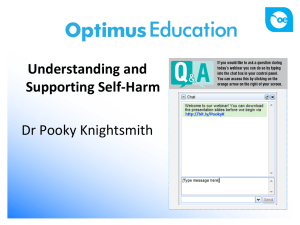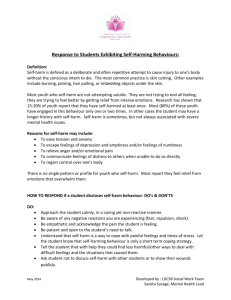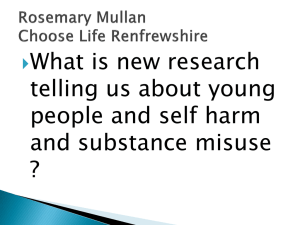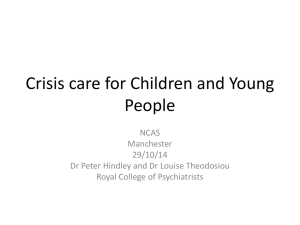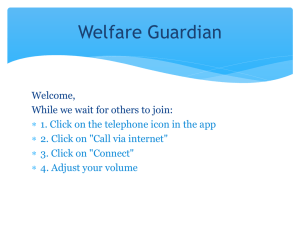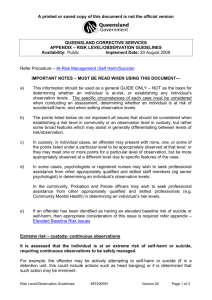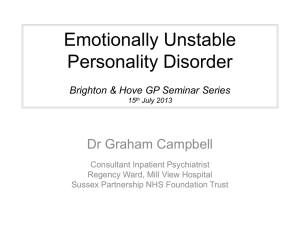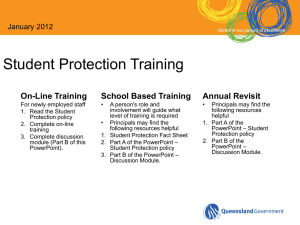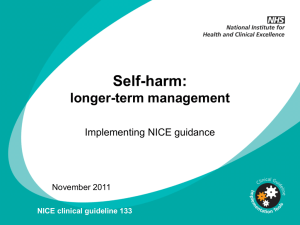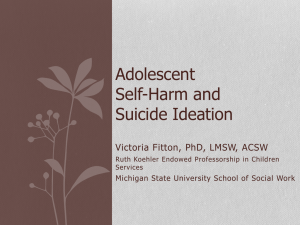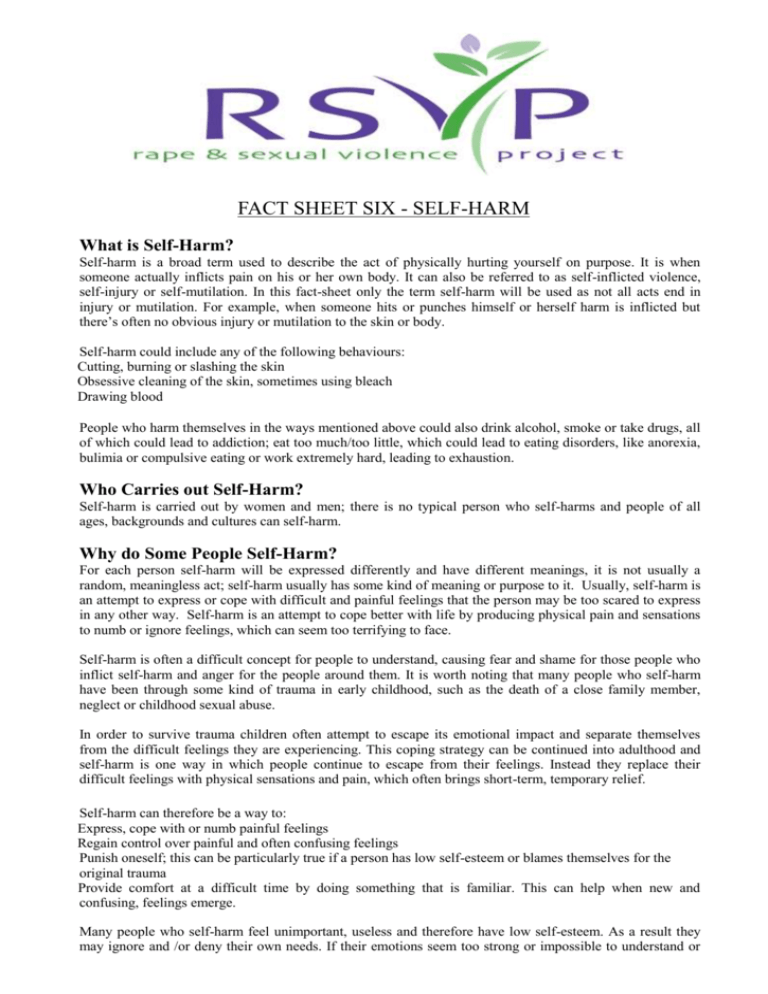
FACT SHEET SIX - SELF-HARM
What is Self-Harm?
Self-harm is a broad term used to describe the act of physically hurting yourself on purpose. It is when
someone actually inflicts pain on his or her own body. It can also be referred to as self-inflicted violence,
self-injury or self-mutilation. In this fact-sheet only the term self-harm will be used as not all acts end in
injury or mutilation. For example, when someone hits or punches himself or herself harm is inflicted but
there’s often no obvious injury or mutilation to the skin or body.
Self-harm could include any of the following behaviours:
Cutting, burning or slashing the skin
Obsessive cleaning of the skin, sometimes using bleach
Drawing blood
People who harm themselves in the ways mentioned above could also drink alcohol, smoke or take drugs, all
of which could lead to addiction; eat too much/too little, which could lead to eating disorders, like anorexia,
bulimia or compulsive eating or work extremely hard, leading to exhaustion.
Who Carries out Self-Harm?
Self-harm is carried out by women and men; there is no typical person who self-harms and people of all
ages, backgrounds and cultures can self-harm.
Why do Some People Self-Harm?
For each person self-harm will be expressed differently and have different meanings, it is not usually a
random, meaningless act; self-harm usually has some kind of meaning or purpose to it. Usually, self-harm is
an attempt to express or cope with difficult and painful feelings that the person may be too scared to express
in any other way. Self-harm is an attempt to cope better with life by producing physical pain and sensations
to numb or ignore feelings, which can seem too terrifying to face.
Self-harm is often a difficult concept for people to understand, causing fear and shame for those people who
inflict self-harm and anger for the people around them. It is worth noting that many people who self-harm
have been through some kind of trauma in early childhood, such as the death of a close family member,
neglect or childhood sexual abuse.
In order to survive trauma children often attempt to escape its emotional impact and separate themselves
from the difficult feelings they are experiencing. This coping strategy can be continued into adulthood and
self-harm is one way in which people continue to escape from their feelings. Instead they replace their
difficult feelings with physical sensations and pain, which often brings short-term, temporary relief.
Self-harm can therefore be a way to:
Express, cope with or numb painful feelings
Regain control over painful and often confusing feelings
Punish oneself; this can be particularly true if a person has low self-esteem or blames themselves for the
original trauma
Provide comfort at a difficult time by doing something that is familiar. This can help when new and
confusing, feelings emerge.
Many people who self-harm feel unimportant, useless and therefore have low self-esteem. As a result they
may ignore and /or deny their own needs. If their emotions seem too strong or impossible to understand or
deal with then destroying those feelings might seem like the only answer. So self-harm then becomes a way
to hide and silence the parts of themselves, which seem too terrifying to express differently. After someone
has self-harmed they could have even more feelings of shame, embarrassment and self-disgust and they
usually attempt to keep the self-harm a secret and hide it away from those around them. This can cause a
further drop in their self-esteem and self-harm could increase as they attempt to cope with the increase of
painful emotions.
Myths about Self-Harm:
“It is a failed suicide attempt”: Self-harm is more closely linked to living, surviving and attempting to cope
with life better rather than being linked with wanting to die. Injuries can be life threatening but are rarely so.
“Self-harm is attention seeking behaviour”: Many people go to great lengths to hide the effects of selfharm. Hurting oneself is not an attention seeking behaviour; it is a way in which someone is trying to cope
with difficult and painful feelings.
“Self-harm is a sign of someone going mad”: Self-harm is a sign of deep distress – not madness.
“People who self harm are a danger to others”: People who self-harm are directing the hurt at themselves
and not at other people. In fact, most people who self-harm would be appalled at the idea of harming anyone
else.
What can help?
If you self-harm:
Any attempt to understand the reasons for and the meaning of your self-harm will be useful.
Keep a diary and ask yourself the following questions:
What is the self-harm saying to you? What does it say about your feelings, your past or your life at the
moment? When did you first start to self-harm? These questions might give you clues about some of the
problems, issues or trauma that you might wish to talk through, either with a partner, friend, and relation or
with a counsellor.
Why do you want to stop hurting yourself? Is it due to pressure from others, a desire to reduce your
feelings of shame and guilt about the self-harm or have you realised that self-harm doesn’t work for
you anymore? These questions might help you to see how strong your motivation to change is. A desire to
stop hurting yourself in order to be a more healthy person, physically and emotionally is usually a positive
sign and a good motivation to do something different.
When are you ready to stop hurting yourself? Have you got people around you who know that you want to
stop harming and who can support you? Have you thought of some different things that you can do
instead of self-harm? E.g. calling a friend or doing something physical (e.g. exercise) to release the
feelings you have inside. These questions might help you to feel more prepared and to make sure that you
have lots of support around you. To replace the self-harm you need different ways of coping with your
feelings and thinking of these can make the idea of stopping the self-harm seem less frightening.
How do you feel before the self-harm? How do you feel after the self-harm? When do you normally selfharm; is there a pattern? Do you have any patterns or rituals which go with the self-harm? E.g. you
always self-harm at the weekend or you always self-harm when you are left alone in the house. These
questions might help you to understand the feelings you are trying to cope with and what you achieve
through self-harm. Also identifying any rituals connected with the self-harm could give you some ideas of
how to changing one thing connected with the self-harm. By changing a ritual you might find that it has an
effect on the self-harm in general.
Read about self-harm (see RSVP’s booklist on self- harm). This will help you to understand your own
behaviour and to gain useful ideas from others who have self-harmed. It may also give you hope that
you are not alone and that you can overcome and change self-harm.
Seek Support. Call the Rape and Sexual Violence Project Helpline on 0121 233 3818 or call our other
numbers (see below). It is usual to have a range of different feelings, which could change from day to day.
Talking to someone, in confidence, could help you make sense of things. A helpline volunteer will listen and
explore your feelings with you. You might feel nervous calling the helpline to ask for support; it takes
courage to call. A volunteer will appreciate this and treat you with respect and sensitivity. All helpline
volunteers are specially trained to speak to anyone affected by rape, sexual assault or childhood sexual
abuse; they can offer support, information and a listening ear. The helpline has an answer-phone that tells
you when we are open. If you call when the helpline is closed you can leave a name and a safe contact
number and a volunteer will call you back.
Call Bristol Crisis Service for Women. They offer a telephone helpline for women in distress about self-harm.
Telephone : 0117 927 9600
If You Want to Support Someone who Self-Harms:
Understand your own feelings about self-harm before offering support. You might feel upset, shocked, hurt
and even disgusted at the self-harm. Whatever you feel, try to identify this feeling before you offer support
and put your feelings to one side. If you don’t understand how you feel about self-harm you might find it
difficult to understand the person you are trying to help.
Recognise that the self-harm is due to emotional pain and distress and it is this turmoil which causes selfharm. Offer your support and accept the self-harm as a way of coping. Ask the person you are supporting to
talk about the self-harm, this could help to reduce their feelings of shame and embarrassment. If they know
that you are not ashamed of their behaviour they will be encouraged to also accept themselves.
Help the person you are supporting to identify other ways to cope with their feelings coping strategies. Be
creative and imaginative and help them to identify many different ways in which their feelings can be
expressed more safely. This is much more helpful than just insisting that the person stops self-harm
immediately.
Get some support for you- talk to a trusted friend or call the Helpline. Supporting some one who
self-harms can be very difficult. You might find yourself thinking that you have been no help at all and that
the person will never change, you could also feel angry and frustrated.
Finally, recognise that you’re not responsible for the person’s behaviour. You cannot stop their self-harm;
this is up to the individual to achieve, with your support.
RSVP office: 0121 643 0301 Helpline: 0121 643 4136
Leaflets, handouts, exercises and posters
This factsheet may be photocopied under the following conditions:
1.
2.
3.
Each page must be copied in its entirety, including RSVP information headings, where applicable.
Copies may be made for use within organisations for training purposes or for clients/individuals for self
help purposes.
Copies may not be resold.

